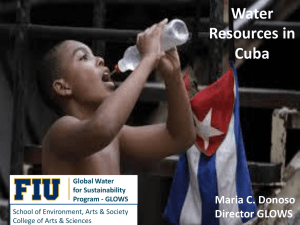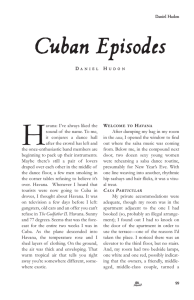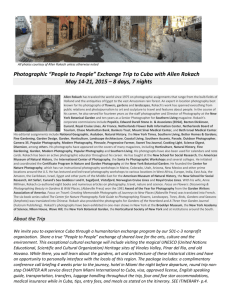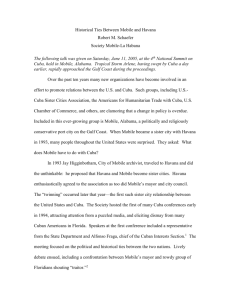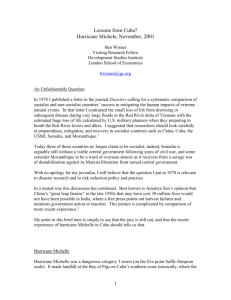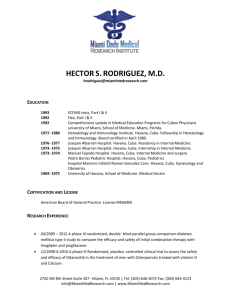Document
advertisement
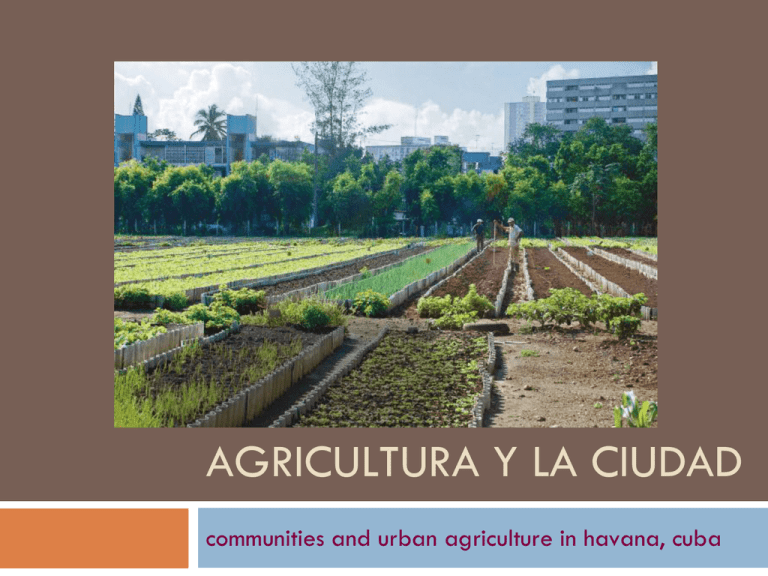
AGRICULTURA Y LA CIUDAD communities and urban agriculture in havana, cuba Overview Background History Reactions to the Crisis Benefits and Critiques Framework Case study Thomson/Freudenburger 2007 Parque Metropolitano de la Habana Long Term Sustainability Changing Cuban Economy Urban Planning History In the early 60’s the United Stated of America tried to crush the revolutionary spirit of Cuba with the most comprehensive trade embargo in history. To survive Fidel Castro established powerful trade relationships to the Soviet bloc. 85% of Cuba’s trade was with the Soviet block Agriculture imports included: 57% of Cuba’s caloric intake 80% of all proteins and fats 80% of all fertilizers and pesticides In 1989, Cuba ranked 11th in the Overseas Development Council’s Physical Quality of Life Index, which includes infant mortality, literacy, and life expectancy. History In 1989 the Soviet block began to unravel Imports dropped by 73% This situation was intensified by: the implementation of the Cuba Democracy Act of 1992 the signing of the Cuba liberty and Democratic Solidarity Act / Helms-Burton Act of 1996 tightened the existing trade embargo that prevented American or American-friendly countries from selling food or medicine to Cuba Reactions to Crisis A resurrecting of agriculture Began to transition from conventional, high-input, monocrop intensive agriculture to smaller organic and semi organic farms Agriculture transportation was reduced or eliminated due to the sacristy of oil. Havana has a population of 2.5 million The post-Soviet crisis incited a massive popular response to the shortage of food, first in the form of gardening in and around the home and then government action to convert all vacant lots to properties of food production. This government effort was facilitated by the Cuban Ministry of Agriculture and more specifically, the Urban Agriculture Department By 1998, there were over 8,000 officially recognized community gardens in Havana, cultivated by more than 30,000 people and covering approximately 30% of the available land. Reactions to Crisis Garden sites were established in close proximity to the gardeners’ households. Land for gardens is obtained through the “Poder Popular” at no cost Gardeners provided food for their families, gave a significant portion to childcare centers, hospitals, and needy community members, and sold the remaining produce for profit. Many Urban areas now produce up to 60% of all Cuban vegetable production Cuba has become practically the only country in the world to begin implementing a bio-logical pest control program on a national scale Over 200 centers have been set up There are over 173 established vermicompost centers, which produce 93,000 tons of natural compost a year using worms. Benefits of Urban Agriculture Availability of food Vacant lots are used productively 100,000 new jobs have been generated Rich variety of crops have become available to communities In Havana production of fresh vegetables and herbs has reached 150g and 200g respectively per capita per day. This benefits the environment and promotes a nutritional culture Empower People and build community Critiques of Urban Agriculture Conducting organic activities does not mean that they are sustainable High irrigation demands Food Theft Insufficient research has been done on toxic elements that may be present in leafy-green vegetables if crops are located in places with high motor-vehicle concentration Smaller farms are less productive Parque Metropolitano de la Habana 700 ha plot of “greenspace” within urban Havana Surrounded by economically, culturally and racially diverse neighborhoods Established “to create an ecologically, economically and socially sustainable park for the enjoyment of Havana’s residents” Create a “green lung” carbon sink for the city Provide an example of sustainable landscaping Promote economic development Parque Metropolitano de la Habana Framework Thomson and Freudenberger 1997 Characteristics of the Resource Food and Nutrition Agricultural Production Potential Soil Fertility Nutrients Contamination Water Climate Availability Characteristics of the Community User Groups PMH Agroforestry Farm Nguyen Van Trói Credit and Service Cooperative Small lots used by individual producers Characteristics of the Rules Government support/regulation of urban agriculture projects Free use of unoccupied, government-owned land for farming project Must fit government standards and expectations Control of markets for sales Credit and Service Cooperative Structure Local Economic Structure Incentives PMH Agroforestry Farm Consistant salary Environmental remediation Government support/resources Nguyen Van Trói Credit and Service Cooperative Shared resources Provides source of credit for farmers Small lots used by individual producers Few incentives to sustainable land use Choices Where to grow? Government land Soil Quality Relation to market Outcomes Incredibly large, relatively efficient output of food for local consumption Establishment of large urban green space Movement towards self-financing and management Dependence upon government programs Subsidy of supplies Production quota Minimal Economic Incentive for Sustainability Failure to improve soils Limited Crop diversity Outcomes Ctd. Little Coordination Between Actors Multiple user-groups in a singular space with specific goals and restrictions Is urban agriculture an appropriate component of the park’s greater objectives? Looking Forward • Sustainability Changing Cuban Economy Renewal of imports Oil and chemical fertilizers/pesticides Effect of farming technique Flight of workforce Increased availability of alternate Urban Development and Farming Threatened agricultural land The role of urban farming in planning and land management Sources Cruz, María Caridad, and Roberto Sánchez Medina. Agriculture in the City: A Key to Sustainability in Havana, Cuba. Ottowa, Canada: International Development Research Center, 2003. Mougeot, Luc J. A. "Moving Between the Plan and the Ground: Shifting Perspectives on Urban Agriculture in Havana, Cuba." Agropolis: the Social, Political, and Environmental Dimensions of Urban Agriculture. London [u.a.]: Earthscan, 2008. 153-86. Print. WARWICK, HUGH. "Cuba's Organic Revolution." Forum for Applied Research and Public Policy 16.2 (2001): 54. Academic OneFile. Web. 8 Apr. 2010. Altieri, M., N. Companioni, K. Canizares, C. Murphy, P. Rosset, M. Bourque, and C. Nicholls. 1999. The greening of the "barrios": Urban agriculture for food security in Cuba. Agriculture and Human Values 16:131-140. 21 22 23


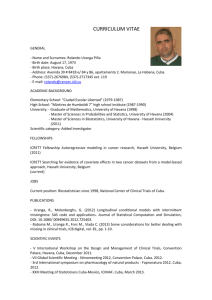


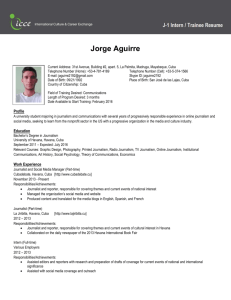


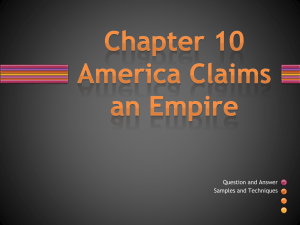
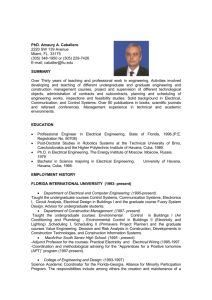
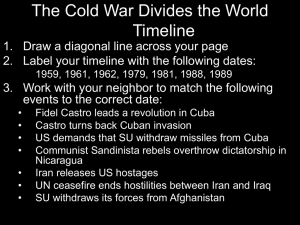
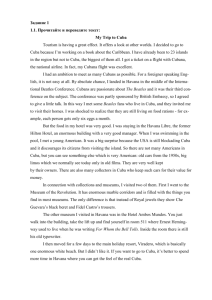

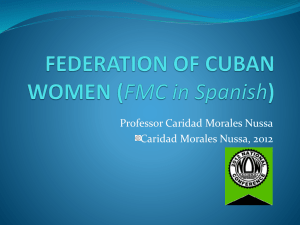
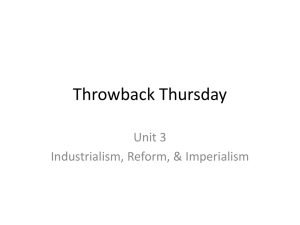
![Multicultural Cuba Full Nov 2014 [1]](http://s3.studylib.net/store/data/006721713_1-ed71f582f1e302b72b1fce8e0b08e55b-300x300.png)
